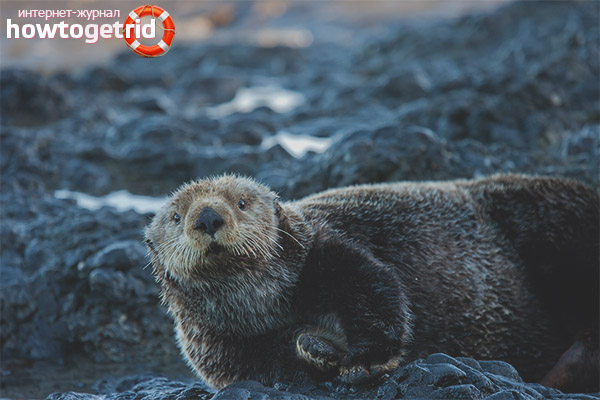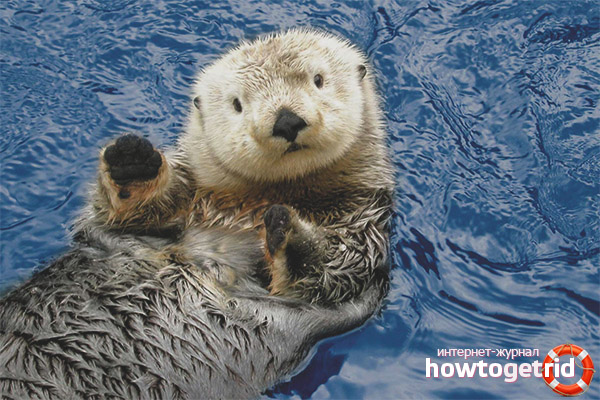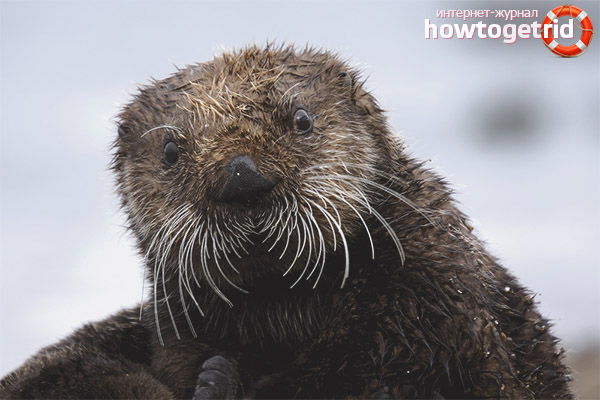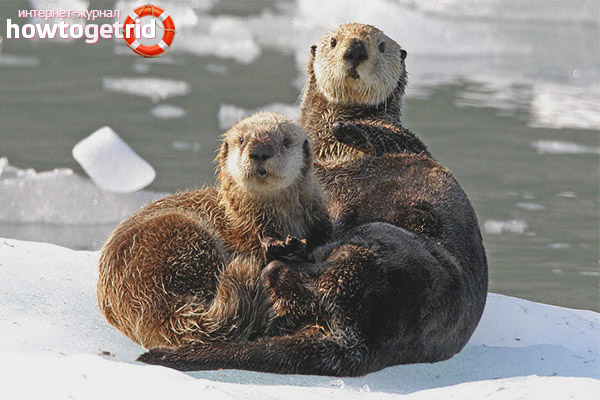The content of the article
Sea otter (sea otter) is a predatory mammal that lives on the Pacific coast of our planet.
Habitat and species features
Sea otters have an average body size. Adult individuals at maturity can reach a length of one to two meters. The average weight of this type of sea otter is 40-50 kg.
They have a particularly large nose of black color, and small black eyes, tiny ears. The color of the fur of such sea otters varies from red to dark brown. Less common are individuals of completely black and white colors. The fur of sea otters provides them with ideal protection against low temperatures. The period of change of otter fur falls in spring and autumn.
The habitual habitat for these representatives of marine fauna is the coast of the Pacific Ocean. So, for example, California sea otters love to be in water open spaces day and night; they go to land only in the morning and in the evening. And those otters that live in the Kamchatka Territory come to the surface only at night. However, an important feature is also the weather conditions. During a storm period, such animals will prefer to stay in the water, and will not swim near the coast.
Sea otters have small paws, which serve as an excellent device for capturing their prey, and are also irreplaceable organs of touch. The hind legs are significantly superior in size to the front, which gives these animals excellent diving and swimming in the vast expanses of water.
Variety of species
Sea otters can be divided into three types:
- Common sea otter.
- Asian sea otter.
- California Sea otter.
Lifestyle and character
The nature of sea otters is considered quite peaceful. They relate without special aggression to other representatives of the terrestrial and aquatic fauna, and to the same extent to humans. It was their peaceful nature that served as the reason for their extermination. Sea otters, without any fear, allowed hunters to approach them.
Under normal living conditions, these water otters live in groups, less commonly found individuals that live their life cycle alone. If a so-called newcomer is nailed to an existing group of sea otters, he is admitted without any problems, the same as leaving the group is not pursued by any problems. It is difficult to calculate the average number in one group, since lonely individuals of both sexes and young sea otters often creep towards them.
Sea otters in the group spend only a small amount of time, and only for the rest period, for example, in thickets of algae or seaweed. This species is not particularly welcome water travel over long distances, however, if this happens, mostly adult male otters swim out.
Their intelligence is very well developed. Sea otters spend the daytime in active mode. The morning of these animals begins with a search for food and putting their hair in order. It is the grooming of their hair that is very important and scrupulous. Sea otters are clean animals.Therefore, the ritual of cleaning fur for them is so important. During it, the animal removes the remains of dirt, twigs, mucus, debris and food debris from the wool, as well as combing old wool. Another feature of the fur of sea otters is that during the ritual of the toilet, animals do not let their hair get completely wet.
At lunchtime, sea otters prefer to relax, in the afternoon they start an active time of games, mating and finding food for dinner.
Nutrition
During quiet weather, these marine fauna prefers to search for food far from the coast. The food search process consists of diving a sea otter to a great depth (on average up to 50 metro) and finding a long amount of time there. After the sea otter got his food for the day, he does not begin to eat it completely, but hides it in his special folds, which in their appearance resemble thick leather pockets. They, in turn, are between the right and left forepaws.
Due to the fact that sea otters lead a rather active lifestyle, they need a lot of energy and, accordingly, feed. On average, a sea otter can eat up to 30% of its weight in one day. The main average diet of sea otter is:
- Most species of marine fish.
- Abalone
- Sea stars.
- Clams.
- Mussels
- Squid.
- Sea urchins.
- Chitons.
- Octopuses (eat only their tentacles).
After the food search process is completed, a sea otter emerges on land and begins the lunch process. As mentioned above in this article, sea otters have a fairly well-developed intelligence, therefore, in order to open the shell of mollusks, they find sharp stones on land or in water and begin to beat them on the shell. It even happens that they carry these devices with them, hiding them in the same pockets that are under their front paws. Also, if food remains, a sea otter hides it there until the next meal. Sea otters never neglect the remnants of food.
After the meal, sea otters begin to clean their wool from the remnants of food and all kinds of garbage. Sea otters quench their thirst with ordinary sea water. Their kidneys are so developed that they can easily process large amounts of salt.
Breeding
During the breeding season (or mating season) sea otters spend most of their free time playing and flirting with the opposite sex. Such games are long diving males for females. And, of course, giving them a lot of attention.
This kind of courtship can last a whole year. There is no definite time of the year for reproduction and flirting in this species of sea otters, however reproduction is possible only after reaching an individual of five years of age. However, it is worth noting that sea otters live on all coasts of the Pacific Ocean. And this means that in some places a certain time of the year is allotted for the mating season. In most cases, it falls in the spring.
Mating occurs by holding a female female by the nose, which does not allow her to break out of her partner's arms. Unfortunately, a long "family" life among sea otters does not exist. Males abandon females about 6-7 days after intercourse and never take an interest in their offspring and no longer take any paternal part. Females go to land during childbirth, where a new individual sea otter is born.
Basically, the mother recognizes only one child, and if two babies are born, then the second simply dies of hunger. Except in those cases if he is not taken into custody by a “single mother,” who for some reason has lost her offspring and who still has a maternal instinct.Like most other newborns on our planet, baby sea otters in the first period of their lives are helpless creatures. Mothers carry them on their stomachs constantly, letting them go for a walk only for a very short period in order to get food. Kids of sea otters can try solid foods on their own only after reaching the age of two months.
Mothers of sea otters spend a lot of time playing with their offspring. In case of danger to the baby, the mother will begin to protect him, risking his own life.
The average life expectancy of these sea otters is not more than 11 years. If the animal spends its life in captivity, then its life cycle can be halved.
Video: Sea otter (Enhydra lutris)













Submit